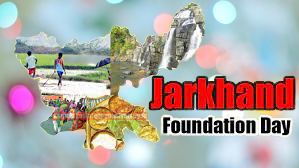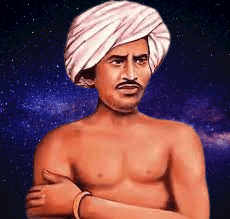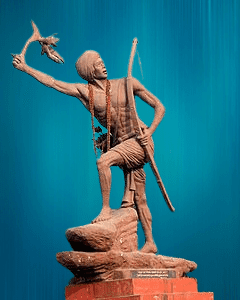Jharkhand Foundation Day: On November 15, the Indian State of Jharkhand celebrates it’s foundation day. The state was carved out of Bihar in 2000 after the Parliament passed the Bihar Reorganization Act, 2000. The day coincides with the birth anniversary of tribal leader Birsa Munda also known as Bhagwan Birsa.
Jharkhand Foundation Day
Jharkhand Foundation Day is celebrated every year on November 15, by the Government of Jharkhand. Jharkhand separated from Bihar after Parliament passed the Bihar Reorganization Act 2000 and Jharkhand from Bihar in the year 2000 celebrates Jharkhand Foundation Day every year on 15 November. Jharkhand Foundation Day is coincident with the birth anniversary of tribal leader Birsa Munda. In Jharkhand, Birsa Munda is known by the name of Lord Birsa.

Jharkhand is also known as the land of jungle or bushland. It is located in Northeast India. Presently, the state of Jharkhand is bordered by Bihar in the north, Uttar Pradesh in the northwest, Chhattisgarh in the west, Odisha in the south and West Bengal in the east.
Jharkhand Foundation Day History
After Indian independence in 1947, New states like Madhya Pradesh, Orissa, and Bihar formed. In 2000 a campaign led by the BJP for a separate state from Bihar state with the passage of the Bihar Reorganisation Act created Jharkhand as a new Indian state. It was formed on November 15th. Jharkhand Foundation Day 2023 coincides with the birth anniversary of tribal leader Birsa Munda, also known as Bhagwan Birsa.

Jharkhand state is rich in minerals like coal, iron ore, copper ore, uranium, mica, bauxite, granite, limestone, silver, graphite, magnetite, and dolomite. Agriculture is the main source of income for 80% population in Jharkhand. Rice is an important cultivation in Jharkhand. Chau is the most famous dance form of Jharkhand. This dance will take place during the Jharkhand Foundation Day 2023 celebration.
Jharkhand was separated from Bihar in 2000. Earlier, it was a part of the southern part of Bihar. It is the homeland of the tribals who had long dreamed of a separate state. After independence, the people of Jharkhand state got the very little socio-economic benefit, especially the tribal people. According to legend, in the 13th century, Raja Jai Singh Deo of Odisha declared himself the ruler of Jharkhand. The state of Jharkhand consists of the Chotanagpur Plateau and the forests of the Santhal Parganas and has various cultural traditions. After independence, regular agitations by the Jharkhand Mukti Morcha led the government to establish the Jharkhand Region Autonomous Council and finally an independent state in 1995.
- After the Independence in 1947, the rulers of the state chose to accede to the Dominion of India.
- The state of Jharkhand was first proposed by a student of St. Columbia’s college in Hazaribagh in 1912.
- In 1928, the Unnati samaj political wing of the Christian tribals Association demanded a tribal state in Eastern India after which a memorandum was submitted to Simon’s commission.
- In 1955 Jharkhand party led by Jaipal Singh Munda submitted a memorandum to the States reorganization commission for a separate Jharkhand state. However, it was rejected due to there being many languages and no link languages in the region, tribals were not in majority, and adverse effects on the economy after separation from Bihar.
- In 1972, Vinod Bihari Mahato, Shibu Soren, and A. K Roy founded the Jharkhand Mukti Morcha and Nirmal Mahato founded the All-Jharkhand Students Union, they together spare headed movement for a separate state of Jharkhand.
- There were differences in the opinion of these parties and they parted away from each other.
- Ram Ratan Ram the then Congress General Secretary urged Rahul Gandhi to pay attention to the issue at hand.
- The committee consisting of Ram Dayal Munda, B.P. Kesari, Vinod Bihari Mahato, Santosh Rana, and Suraj Singh Besara started a fresh initiative on the matter.
- The central government formed a committee on the Jharkhand matter in 1989 and its stressed the need for greater allocation of the development funds for the area.
- In December 1994 the Jharkhand Area Autonomous Council Bill passed in Bihar Legislative Assembly.
- In 1998 the separate state movement was falling apart, however, it was led by justice Lal Pingley Nath Shahdeo.
- In 1998 the union government decided to send the bill concerning the formation of the Jharkhand state to the Bihar Legislative Assembly to which Lalu Prasad Yadav said that the state would be divided over his dead body.
- The voting on Jharkhand was done on 21st September 1998 in Bihar legislation and on that day the committee under the leadership of Shahseo called for a Jharkhand bandh and organized a protest march.
- After the last assembly election in the state resulted in a hung assembly, RJD’s dependence on the Congress extended support on the precondition that RJD would not pose a hurdle to passage of the Bihar the organization bill.
- Finally, with the support of both RJD and Congress the ruling coalition at the center led by the Bharatiya Janata Party, which made statehood its mean pole plank in the region in successive poles earlier, cleared the Bihar organization bill in the monsoon session of the Parliament that year.
- Paving the way for the creation of a separate Jharkhand state comprising Chota Nagpur division and Santhal Pargana division of South Bihar.
It has an area of 79,714 km² (30,778 sq mi). It is the 15th largest state by area, and the 14th largest by population. Hindi is the official language of the state.The city of Ranchi is its capital and Dumka its sub capital. The state is known for its waterfalls, hills and holy places: Baidyanath Dham, Parasnath and Rajrappa are major religious sites.
Facts about Jharkhand
| Interesting Facts About Jharkhand | |
| Name of the State | Jharkhand (The word “Jhar” means ‘forest’ and “Khand” means ‘land’) |
| Country | India |
| Also Known as | Land of Forests |
| Location | Eastern India |
| State Borders | West Bengal to the east, Chhattisgarh to the west, Uttar Pradesh to the northwest, Bihar to the north and Odisha to the south. |
| Formation Date | 15th November 2000 |
| Previously | In Bihar state |
| State Capital | Ranchi |
| Largest City | Jamshedpur |
| Number of Districts | 24 |
| Total area | 79,716 km2 (30,779 sq mi) |
| Position in Area | 15th largest state in India |
| Length | 380 km (240 mi) |
| Width | 463 km (288 mi) |
| State BIRD | Kokil(Asian Koel) |
| State Animal | Indian Elephant |
| State Flower | Palash(Butea monosperma) |
| State Tree | Sal (Shore robusta) |
| Population as on 2023 | 4.06 crores (40.6 million) |
| Population as per 2011 Census | 32966238 (3.29 Crores) |
| Population as per 2001 Census | 26,945,829 |
| Literacy Rate 2023 | 66.41 |
| Male literacy | 76.84 |
| Female literacy | 55.42 |
| Largest District | Pashchimi Singhbhum |
| Smallest District | Ramgarh |
| Least populated District | Lohardaga |
| Most populous district | Ranchi |
| Official Language | Hindi |
| Total Forest Area | 23,553 Sq. Km. (29.55%) |
| First in JHARKHAND State | |
| First Governor | Prabhat Kumar |
| First Female Governor | Draupadi Murmu |
| First Chief Justice | Justice Vinod Kumar Gupta |
| First Female Chief Justice | Justice Gyan Sudha Mishra |
| First Legislative Assembly Speaker | Indar singh Namdari |
| First Legislative Assembly Deputy Speaker | Bagun Sumbrai |
| First Chief Minister | Babulaal Marandi |
| First Non-Tribal Chief Minister | Raghuvir Das |
| First Independent Chief Minister | Madhu Koda |
| First Woman Cabinet Minister | Joba Manjhi |
| First Chief Secretary | Vijayshankar Dubey |
| First Leader of Opposition | Stephen Marandi |
| First Director General of Police | Shivaji Mahan Kaire |
| First Solicitor General | Mangalmay Banarjee |
| First Lokayukta | Justice Laxman Oraon |
| First Nominated Assembly Member | Joseph Pecheli Golsten |
| First Ashoka Chakra recipient | Randheer Verma |
| First Paramveer Chakra recipient | Albert Ekka |
| First International Tribal Women Hockey Player in the State | Savitri purti |
| First University of State | Ranchi University, Ranchi |
| First Medical College of State | Rajendra Medical College, Ranchi |
| First College of State | Saint Kolamba College, Hazaribagh |
| First Chairman of JPSC | Phatik Chandra Hembrum |
| The First Chairperson of the Women’s Commission of State | Laxmi singh |
| First Indian Cricket Captain from State | Mahendra Singh Dhoni |
| First Steel Plant of State | Jamshedpur |
| The Captain of the State’s Hockey team Participating in the Olympics | Jaipal singh Munda |
| The First Industrialist of the State who received the Bharat Ratna | J.R.D. Tata |
| First Tribal Revolution | Dhal Revol (year 1767–77) |
| Tallest Waterfall in the State | Budha Ghag waterfall (Lodh Falls), Latehar |
| Largest River Valley Project in the State | Damodar River Valley Project |
| Largest Airport in the State | Birsa Munda Airport, Ranchi |
| Highest Peak in the State | Parasnath |
| Hottest Water Body of State | Suryamund (Hazaribagh) |
| State’s Nearest District by Sea | East Singhbhum |
| Longest River of State | Damodar |
| First Ayurveda college of state | Government Ayurveda College, Lohardaga |
| First Hindi Daily Newspaper in the State | Rashtriya Bhasha |
| First Hindi Monthly Magazine in the State | Gharbandhu |
| First English Daily in the State | Daily Prem |
| State’s First Film | Akrant |
| State’s first Nagpuri Film | Sona kar Nagpur |
| State’s First Copper Factory | Ghatshila |
| Coldest Place in the State | Netarhat (Latehar) |
| State’s Highest Rainfall | Netarhat |
| State’s Largest Forest (density) | Saranda |
| State’s First Power Station | Tilaiya |
| The First Railway in the State | From Rajmahal to Deen Dayal Upadhayay (Mughalsarai) junction |
| State River Freely Falling into the Sea | Swarnrekha |
| Most Pilgrim City | Deoghar |
| Cities with Population more than One Lakh in the State | 10 |
| No. of Metro Cities in the State | 2 (Dhanbad, Jamshedpur) |
| Largest Tribe by Population | Santhal |
| Most Developed Tribe of Jharkhand | Oraon |
| Oldest Tribe of Jharkhand | Asur |
| The First Festival of the Tribes of Jharkhand | Sarhul |
| State’s Most Forested District (area) | West Singhbhum (3,914 sq. Km.) |
| Most Forested District in the state in terms of Percentage | Chatra (47.70%) |
| Most Scheduled Tribe District of the State | Ranchi |
| Most Scheduled Tribe Division of the State | Santhal Pargana |
| Script of Santali Language | Ol Chiki script |
| Establishment of Tata Iron and Steel Company | In 1907 |
| Project Tiger set up in Palamu | In 1973 |
| The District with the Highest Number of Waterfalls in the State | Ranchi |
| The First Railway Line Built by Mining in the Plateau Areas of the State | Jamshedpur to Howrah RailLine |
| Famous as Queen of Hills in the State | Netarhat (Chhotanagpur) |
| Steel City of State | Tatanagar |
| Establishment of First Cement Industry in the State | In Japla |
| State Mining Higher Education Center | Indian school of mines |
| Aviation and Gliding Club in the State | Jamshedpur |
| Biggest Museum | Ranchi |
| Biggest Zoo | Bokaro |
ABOUT BIRSA MUNDA
Though he lived a short span of life, Birsa Munda is known to have mobilized the tribal community against the British and had also forced the colonial officials to introduce laws protecting the land rights of the tribals.
Birsa Munda was a young freedom fighter and a tribal leader, whose spirit of activism in the late nineteenth century, is remembered to be a strong mark of protest against British rule in India. Born and raised in the tribal belt around Bihar and Jharkhand, Birsa Munda’s achievements are known to be even more remarkable by virtue of the fact that he came to acquire them before he was 25. In recognition of his impact on the nationals movement, the state of Jharkhand was created on his birth anniversary in 2000.
Born on November 15, 1875, Birsa spent much of his childhood moving from one village to another with his parents. He belonged to the Munda tribe in the Chhotanagpur Plateau area. He received his early education at Salga under the guidance of his teacher Jaipal Nag. On the recommendation of Jaipal Nag, Birsa converted to Christianity in order to join the German Mission school. He, however, opted out of the school after a few years.
The impact of Christianity was felt in the way he came to relate to religion later. Having gained awareness of the British colonial ruler and the efforts of the missionaries to convert tribals to Christianity, Birsa started the faith of ‘Birsait’. Soon members of the Munda and Oraon community started joining the Birsait sect and it turned into a challenge to British conversion activities.
During the period, 1886 to 1890, Birsa Munda spent a large amount of time in Chaibasa which was close to the centre of the Sardars agitation. The activities of the Sardars had a strong impact on the mind of the young Birsa, who soon became a part of the anti-missionary and anti-government program. By the time he left Chaibasa in 1890, Birsa was strongly entrenched in the movement against the British oppression of the tribal communities.
On March 3, 1900, Birsa Munda was arrested by the British police while he was sleeping with his tribal guerilla army at Jamkopai forest in Chakradharpur. He died in Ranchi jail on June 9, 1900 at a young age of 25. Though he lived a short span of life and the fact that the movement died out soon after his death, Birsa Munda is known to have mobilised the tribal community against the British and had also forced the colonial officials to introduce laws protecting the land rights of the tribals.
Birsa’s achievements as a young tribal revolutionary has continued to be celebrated over decades now and he has successfully carved out a space for himself in popular and folk literature, academia, and mass media.

Birsa Munda Jayanti, celebrated on November 15th each year, is a significant occasion in India, especially in the state of Jharkhand. This day honors the birth anniversary of Birsa Munda, a revered tribal leader and freedom fighter who dedicated his life to the welfare of tribal communities and the struggle against British colonial oppression. On this day, people from diverse backgrounds come together to commemorate Birsa Munda’s contributions to the Indian freedom movement and the preservation of tribal culture.
Various events, cultural programs, and discussions are organized to pay homage to his enduring legacy. Birsa Munda Jayanti serves as a reminder of the importance of tribal rights, social justice, and the need to protect and celebrate the rich cultural heritage of indigenous communities in India. It is a day of reflection, inspiration, and renewed commitment to the principles that Birsa Munda stood for.
Follow read4knowledge for more relevant articles.